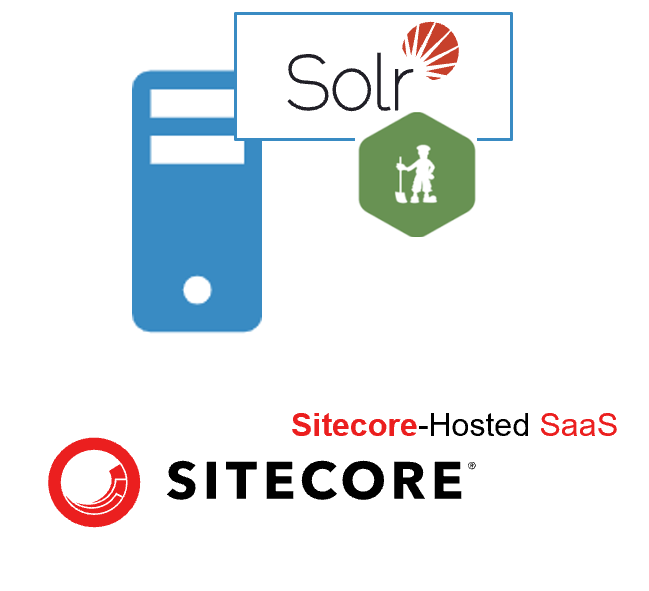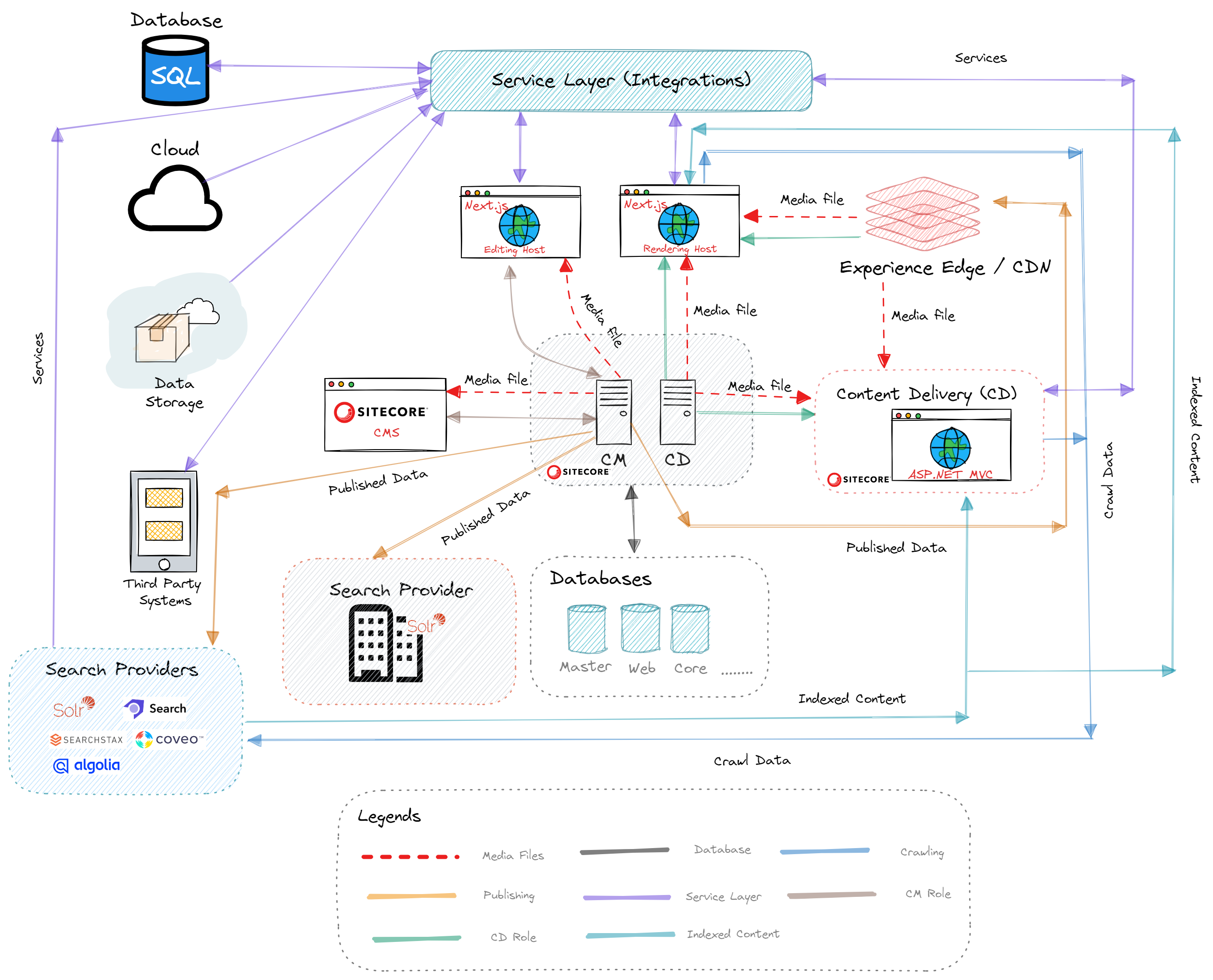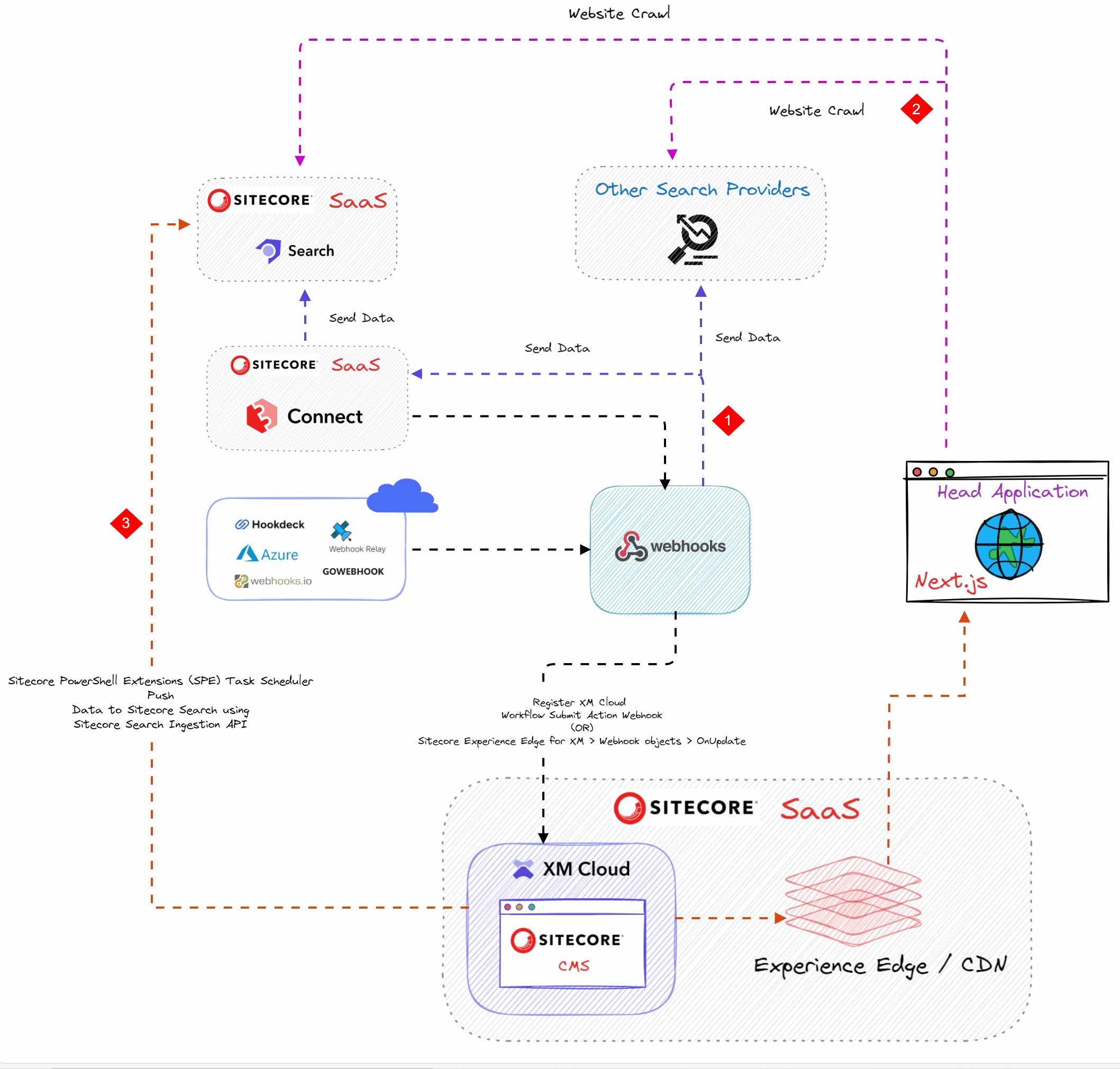Exploring Search Options in Sitecore XM Cloud
 Amit Kumar
Amit Kumar
👋Introduction
Sitecore Experience Manager Cloud, or XM Cloud, is a SaaS enterprise-ready, cloud-native content management system (CMS) that offers complete CMS capabilities in the cloud, managed and provided by Sitecore.
Sitecore XM Cloud provides powerful tools to boost content discovery and user experience. In this article, we will explore the different search options available in Sitecore XM Cloud, how to use its built-in search, and how to access published content in your front-end applications for users.
💡Understanding Search Capabilities in Sitecore XM Cloud
In XM Cloud based Sitecore implementations, the Search implementation required for two types of applications:
Content Management (CM)
Front-end (FE)
Content Management (CM)
The Content Management System (backend system) allows authors to create, manage, and publish content. It uses search indexes to find content. For example, content authors can quickly search for items in the Content Tree using advanced search features like filters and facets. 🔝
When working with the Sitecore Content Management system (traditional or headless), you can use the default search provider, Solr, for internal Sitecore CMS searches.

Front-end (FE)
The search instance for the front-end (FE) app is used to meet the search needs of the FE app (Sitecore Rendering Host). It is the responsibility of the client or implementation partner to set it up. 🔝
In Sitecore XMC, the Content Delivery role isn't needed because the website isn't hosted in XM Cloud. Instead, the front-end website can be hosted on Vercel or other hosting providers based on your needs. XMC publishes the CMS content to Sitecore Experience Edge, not to the web database (so the content is indexed in the web index).
In XM Cloud, content delivery happens through Sitecore Experience Edge, which provides an Edge GraphQL endpoint (CDN enabled). This allows the front-end app to retrieve the page's presentation details from the CMS to build the page. 🔝
To improve search functionality and user experience on your website, you can use Sitecore Search to quickly index content from documents and websites. It provides the tools and support needed for finding and retrieving content.
There are other options available to index or crawl website content and documents, such as Solr (with Zookeeper), SearchStax (SaaS), Coveo (SaaS), and more.
Sitecore Searchhere 👇
Reference Architecture
Sitecore Headless implementations can be architected in various ways to suit different use cases and requirements. At the core, the architecture decouples the front-end presentation layer from the back-end content management system using Sitecore's Headless CMS capabilities. 🔝
Different ways to access content and media items, plus integration with search providers and third-party systems

A high-level reference architecture typically includes a content access layer, where Sitecore's GraphQL API or Headless API provides access to content items, layouts, and metadata.
The diagram above shows the Sitecore ASP.NET MVC and Sitecore Headless application with options for content delivery, media items, and search providers.
In the above diagram:
Sitecore CMS application accesses the content and media items from the CM role.
Sitecore Editing Rendering Host application accesses the content and media items from the CM role.
Approved content from the CM role can be published to your chosen search provider using connectors, or to Sitecore Experience Edge.
The front-end app can access content and media items from the CD role or from Sitecore Experience Edge.
The front-end app can access media items from the CD role, Sitecore Experience Edge, CDN, or DAM.
Front-end app content can be indexed using crawling, connectors, custom implementation, or a Webhook.
The front-end app can access indexed content using the service layer or directly through the Search APIs.
The front-end app can access the service layer, which integrates with upstream and downstream systems. 🔝
Integrate XM Cloud with Sitecore Search

You can index website content in XM Cloud in these ways:
1. You can use the Sitecore XM Cloud Workflow notification to determine which content state has changed and send specific data to Sitecore Search through the Webhook.
The Sitecore XM Cloud provides three types of webhooks:
Webhook event handler
Webhook submit action
Webhook validation action
For our use case, we can use the Webhook submit action when an item moves to the approved state. The XM Cloud workflow webhook will then send the notification to the specific endpoints with the required data. 🔝
You can also try the Edge Webhook’s OnUpdate event to get the updated data directly from Sitecore Experience Edge. You can find more details at Sitecore Experience Edge for XM > Webhook objects.
With this approach, we can utilise Sitecore Connect, which will send the data to Sitecore Search for indexing with its Low-code / No-code integration platform.
You can create a custom Workato Webhooks connector and use it in Sitecore Connect (Sitecore's SaaS product).
2. You can use Sitecore SearchAdvance Web Crawler to crawl the data (or content) from your website.
3. You can also use the Sitecore PowerShell Extensions (SPE)task scheduler to run scripts at specific times. This means you can create an SPE script that checks the state of items and pushes those items to Sitecore Search using the Sitecore Search Ingestion API.
💡 Sitecore XM Cloud is a SaaS platform, so we need to avoid deploying any custom code to the Sitecore XM CMS instance.
🤝Conclusion
Remember that Sitecore XM Cloud helps you create great customer experiences by managing and delivering content across different channels. With Sitecore APIs, headless CMS features, and Edge GraphQL, you can provide users with a smooth and fast experience. Use the power of Sitecore XM Cloud to improve your digital experience.
I’ve provided an overview of search capabilities and content access options in Sitecore XM Cloud. Let me know if you’d like additional details or have other queries! Feel free to explore these features more, and if you have any specific questions, just ask! 😊
🙏Credit/References
🏓Pingback
| SearchStax-Sitecore SiteSearch - Intuitive Sitecore Site Search | Surface hyper-relevant content through AI-powered search | Sitecore Search |
| search in sitecore xm cloud | search in xm cloud | sitecore xm cloud search |
| sitecore xm cloud | xm cloud search | sitecore xm vs xm cloud |
| sitecore xm cloud cli | sitecore xm architecture | sitecore xm |
| sitecore xm vs xp | sitecore searchstax | xm cloud sitecore |
| sitecore xm cloud solr search | what is sitecore xm | sitecore xm cloud documentation |
| search for sitecore xm cloud | Understanding the Sitecore Search Capabilities for XM | Does Sitecore XM Cloud support custom code |
| How to search an item in the content tree? | How to search text in Sitecore? | What is Sitecore search? 🔝 |
| Which is better content hub one or XM cloud? | search options for xm cloud | Sitecore Search and XM Cloud - Experiences and Learnings |
| Sitecore Search - Adding an Index Source | How to use search in xm cloud | Sitecore Search with XM Cloud |
| Sitecore Search login | Sitecore Search documentation | Sitecore Search implementation |
| Sitecore Search Documentation | Searching | Find the most relevant content throughout our site |
| Sitecore Discover - AI-Powered Search & Merchandizing | What is AI-powered search? | Getting started with Sitecore Search🔝 |
| Search and indexing overview | Search for an item | Sitecore search google |
| Sitecore search app | sitecore search product | sitecore search api |
| sitecore search ai | sitecore discover | sitecore connect |
| Sitecore Search insights | Optimizing Sitecore Search | Sitecore search engine |
| Advanced search capabilities | Sitecore search architecture | Enhancing user experience with Sitecore Search |
| Sitecore indexing process | Understanding search in Sitecore | Sitecore search features |
| Leveraging Sitecore for efficient search | Sitecore search best practices | Sitecore search strategies |
| User-centric Sitecore Search | Boosting engagement with Sitecore Search | Sitecore content discovery through search |
| Sitecore Search for developers | Customizing Sitecore search | Sitecore Search and SEO |
| Sitecore Search and content relevance | Sitecore Search implementation tips | search engines 🔝 |
| drupal search | kentico search | umbraco search |
| liferay search | sitecore support | coveo for sitecore |
| sitecore search engine | solr sitecore | failed to start service sitecore xconnect search indexer |
| sitecore solr search | sitecore content search | solr search in sitecore |
| sitecore solr search example c# | sitecore azure search | sitecore search by field value |
| sitecore contentsearch | solr in sitecore | sitecore site search |
| sitecore elasticsearch | coveo search sitecore | sitecore lucene |
| sitecore acquires reflektion | azure search sitecore | sitecore 9 solr search example |
| sitecore solr search example | search in sitecore | sitecore contentsearchmanager |
| coveo sitecore integration | sitecore solr computed field | site search sitecore 🔝 |
| coveo search for sitecore | sitecore faceted search | what is sitecore search |
| what is solr search in sitecore | what is sitecore | sitecore searchstax |
| what is xm cloud | Sitecore XM Cloud Architecture overview | what is sitecore xm cloud |
| Sitecore Experience Manager Cloud (XM Cloud) Building blocks | Deploying XM Cloud | Sitecore Headless SXA |
| Sitecore Headless SXA | sitecore jss nextjs | sitecore jamstack |
| The architecture of Sitecore Experience Edge for XM | sitecore toplogies | Elevating Your Sitecore Next.js App with Tailwind CSS: A Perfect Union of Design and Performance |
| Default topologies - Sitecore Documentation | Solutions for your digital experiences | XM topology for on-premises |
| XM Cloud Recommended Practices - Sitecore | XM Cloud FAQ | If XM Cloud Is A Headless CMS, What Does That Mean? |
| What Problems Does XM Cloud solve? | What’s the difference between Experience Manager, Experience Platform, and XM Cloud? | Sitecore XM Cloud Limitations and restrictions🔝 |
| Limitations and restrictions of Experience Edge for XM | Sitecore Experience Manager (XM) Build Experiences That Connect | Sitecore Experience Edge GraphQL Queries |
| what is sitecore experience edge and what is Sitecore XM Cloud? | Sitecore XM Cloud: The Modern SaaS CMS | sitecore experience edge connector |
| What is the difference between Sitecore XM and XM cloud? | Which is better content hub one or XM cloud? | sitecore experience edge architecture |
| XM Cloud Introduction | sitecore XM Cloud Components in Action | Sitecore XM Cloud: Getting Started with Personalization and ... |
| Sitecore Experience Manager Cloud | Sitecore Experience Manager Cloud (XM Cloud) | Sitecore/XM-Cloud-Introduction: A XM Cloud repository containing |
| A Complete Guide to Upgrade to Sitecore XM Cloud | Sitecore XM Cloud. Sitecore Composable DXP | sitecore experience editor |
| sitecore xm cloud | sitecore xm cloud components | sitecore xm architectur |
| sitecore xm cloud architecture | sitecore xm documentation | sitecore xm cloud login |
| sitecore xm cloud vercel | sitecore xm cloud vs xp | sitecore xm cloud local setup |
| sitecore edge🔝 |
Subscribe to my newsletter
Read articles from Amit Kumar directly inside your inbox. Subscribe to the newsletter, and don't miss out.
Written by

Amit Kumar
Amit Kumar
My name is Amit Kumar. I work as a hands-on Solution Architect. My experience allows me to provide valuable insights and guidance to organizations looking to leverage cutting edge technologies for their digital solutions.As a Solution Architect, I have extensive experience in designing and implementing robust and scalable solutions using server-side and client-side technologies. My expertise lies in architecting complex systems, integrating various modules, and optimizing performance to deliver exceptional user experiences. Additionally, I stay up-to-date with the latest industry trends and best practices to ensure that my solutions are always cutting-edge and aligned with business objectives.